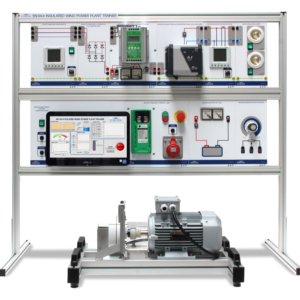EN 01.4PC – Computerized Stand Alone Photovoltaic Installation Demonstrator
The equipment EN 01.4 has been designed as a stand alone photovoltaic solar power plant, with 2 modules and all the elements necessary to complete the installation.
The equipment consists of: 2 photovoltaic panels of 20Wp, 2 batteries, a voltage regulator, an inverter, a pyranometer, different loads in DC and AC, and modules of control with PC (PC included).
This working station is equipped with tension and current meters in the key sections, to make it easy for the student to understand its operation.
The system works in exactly the same way as the photovoltaic stand alone facilities of electrical generation, that are normally used on boats, caravans, pumping groups, or remote locations where access to the public mains does not exist.
In addition, this equipment allows for the connection of the panels and the batteries, in series or in parallel.
- Study of the operation of a photovoltaic solar installation.
- Isolated panels.
- Modules connected to batteries.
- Operation with different types of loads in DC.
- Conversion of DC to AC.
- Operation with different types of loads in AC.
- Efficiency of the installation.
- Determination of the characteristics of the solar modules.
- Current – Voltage Curve.
- Current in short circuit.
- Voltage of open circuit.
- Curve Power – Voltage.
- Curve Power – Resistance of load.
- Maximum power generated.
- Form factor.
- Efficiency.
- Influence of the tilt angle and the intensity of solar radiation in the generated energy.
- Determination of the characteristics of the modules connected in series.
- Determination of the characteristics of the modules connected in parallel.
- Study of the behavior of the solar modules in diverse conditions of operation.
- Isolated panels.
- In parallel with different loads.
- In series with different loads.
- Connected panels to batteries in series.
- In parallel with different loads.
- In series with different loads.
- Connected panels to batteries in parallel.
- In parallel with different loads.
In series with different loads.
- Photovoltaic modules: 2 photovoltaic modules of 20Wp.
- Cooling system for the photovoltaic system by fans.
- Pyranometer for the measurement of the solar intensity.
- Charge controller: Charge controller with operation at 12 or 24V CC, and max. current=10A. Max. input voltage= 45V.
- Batteries: 2 Batteries 12V 10Ah.
- Inverter: 200 VA stand alone inverter, with single-phase output.
- Analog and digital voltmeters of 4 digit with 12 bits + sign resolution.
- Analog ammeters with digital positive and negative measuring (zero centered) and 4 digit digitals with 12 bits + sign resolution.
- Direct currrent halogen lamps.
- Direct current LED white lamps.
- Alternating current low consumption lamps.
- Rheostat for analysis of the voltage-current graph in the solar modules and comparison with the specifications. It allows parallel or series connection.
- Data acquisition card.
- The equipment is provided with a complete step by step guide.
- Computer integrated into the equipment with teaching software.
- Photovoltaic panels structure: 895x650x1740 mm.
- Panel modules structure: 500x1300x790 mm.
- Power supply: 230W/50Hz









